
17 minute read
LISBOA E PORTO LISBON AND PORTO

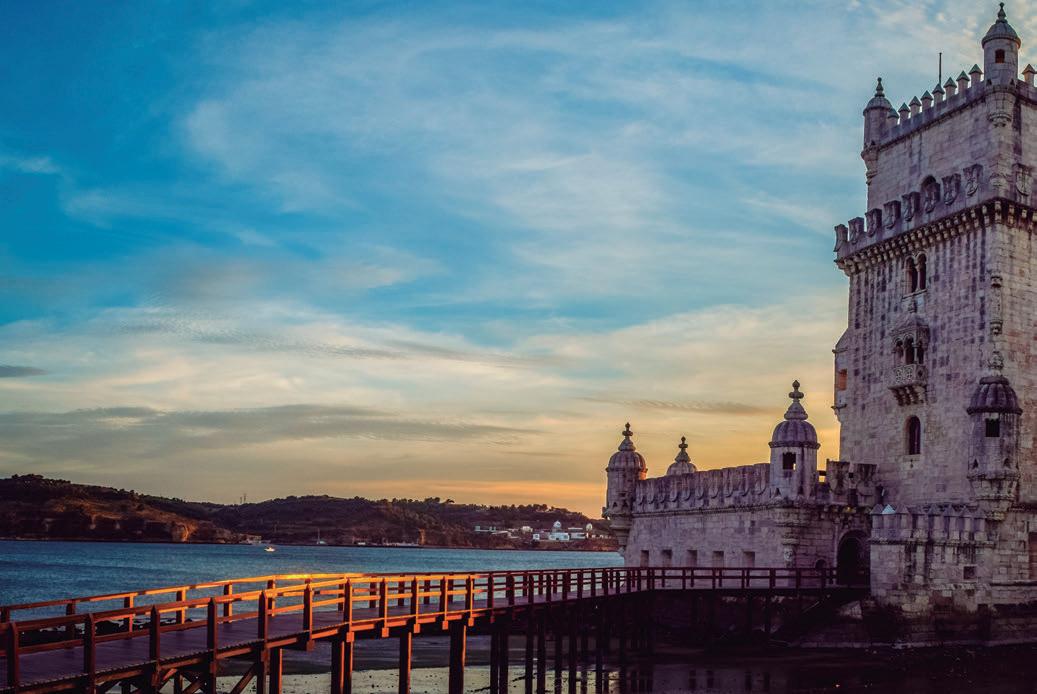
Advertisement

Lisboa e Porto



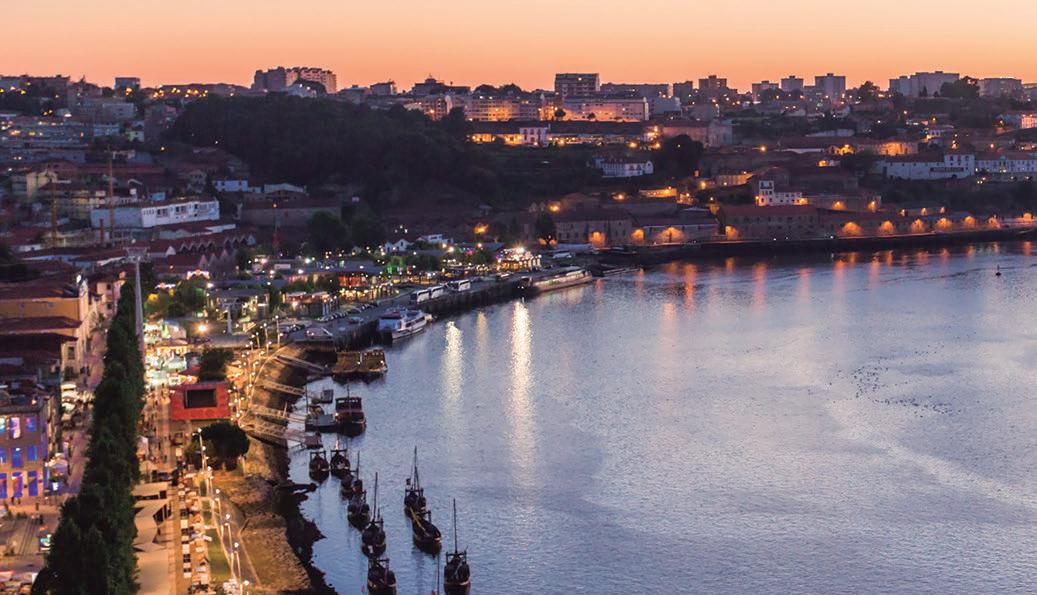


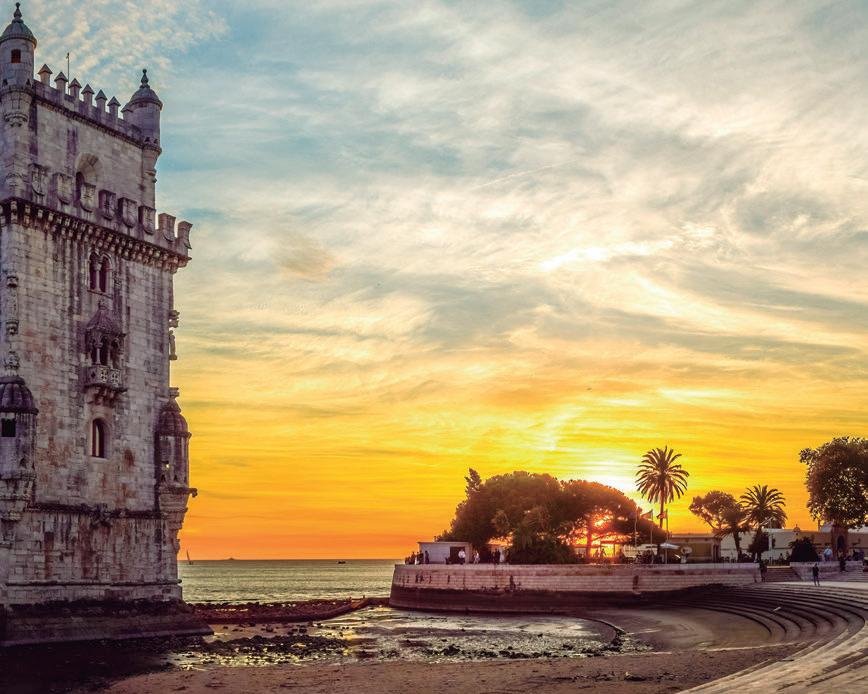
UMA HISTÓRIA PARA DUAS CIDADES TWO HISTORICAL CITIES

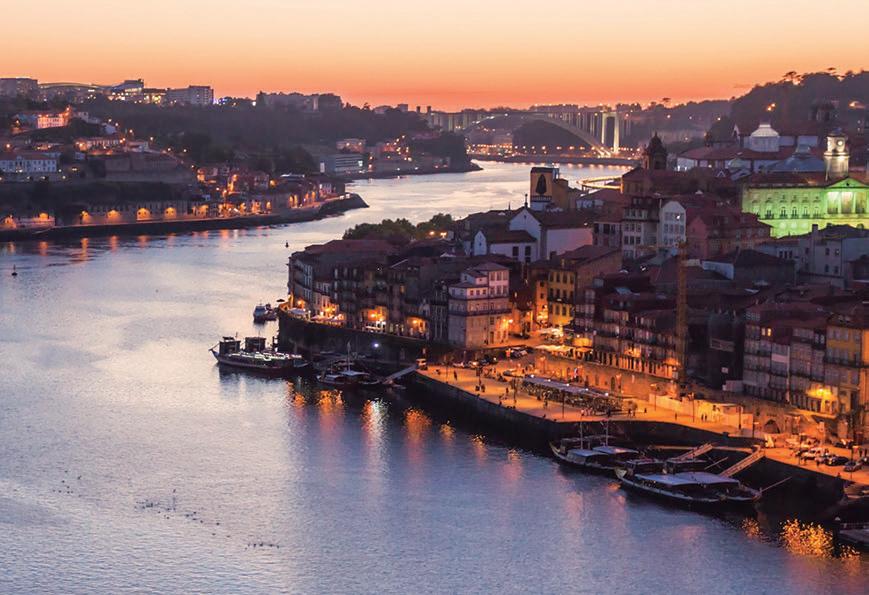


SE LISBOA É A CAPITAL DE PORTUGAL, FOI O PORTO QUE DEU O NOME AO PAÍS. OS CERCA DE 300 QUILÓMETROS QUE DIVIDEM AS DUAS PRINCIPAIS CIDADES PORTUGUESAS TÊM HISTÓRIA E HISTÓRIAS ÚNICAS QUE DEFINEM BEM A PERSONALIDADE DE CADA UMA. FIQUE A CONHECER A ORIGEM DE AMBAS.
IF LISBON IS THE CAPITAL OF PORTUGAL, IT WAS THE CITY OF PORTO THAT GAVE ORIGIN TO THE NAME OF THE COUNTRY. THE APPROXIMATELY 300 KILOMETRES SEPARATING THE TWO MAJOR PORTUGUESE CITIES HAVE HISTORY AND UNIQUE STORIES WHICH DISTINCTIVELY DEFINE THE CHARACTER OF EACH CITY. FIND OUT MORE ABOUT THE ORIGIN OF BOTH OF THEM.

P R Ó X I M A P A R A G E M N E X T S T O P
Diz-se que no Porto trabalha-se enquanto em Lisboa diverte-se. Só isto seria suficiente para definir uma e outra cidade, mas o certo é que, tanto numa como noutra, trabalha-se muito para garantir que o visitante se possa divertir. Entre ruas rodeadas de charme, restaurantes com comida de qualidade, ofertas culturais para todos os gostos e locais de diversão, Lisboa e Porto partilham raízes históricas que as transformam, ao mesmo tempo, em cidades complementares. Uma viagem a Portugal sem a visita a estas duas cidades, nunca será uma viagem completa. Lisboa, a capital, é, acima de tudo, uma das cidades mais antigas do mundo. Com cerca de 1200 anos de existência Antes de Cristo, só Atenas, na Grécia, será a mais antiga das capitais da Europa. A origem do nome, por exemplo, perde-se nos tempos, tendo sido necessário inventar lendas ou especular sobre a real origem do nome Lisboa. Uma dessas lendas evoca inclusive o Antigo Testamento. Conta-se que Elisá, bisneto de Noé, chegou a estas paragens 278 anos após o grande dilúvio. Elisá teria navegado pelo Mediterrâneo até ao Atlântico, onde fundou a cidade que hoje se chama Lisboa, sendo essa a origem do topónimo. Mas, a história que provavelmente mais ouvirá nas ruas da cidade é aquela que menciona Ulisses, o rei de Ítaca e herói mitológico grego, protagonista da “Odisseia” de Homero. Diz-se que, após It is said that people in Porto work while people in Lisbon have fun. This alone would be enough to define each city, but the truth is that both cities work hard to assure that visitors have a lot of fun. Among streets brimming with charm, restaurants serving quality food, culture offers to suit every taste and places of entertainment, Lisbon and Porto share the same historical genesis which have, simultaneously, transformed them in complementary cities. A trip to Portugal without visiting these two cities will never be a complete trip. Lisbon, the capital, is above all one of the oldest cities in the world. Having around 1,200 years of existence before Christ, only Athens, in Greece, is the oldest of the capitals in Europe. The origin of the name, for example, was lost in time, and it was necessary to make up tales or speculate about the actual origin of the name “Lisboa” (Lisbon). One of those tales mentions the Old Testament. It is said that Elishah, great-grandson of Noah, arrived here 278 years after the great flood. Elishah would have navigated from the Mediterranean to the Atlantic, where he founded a city today called Lisbon, being that the origin of the toponym. But the story that you will most likely hear in the streets of the city is the one mentioning Ulysses, the king of Ithaca and a Greek mythological hero, protagonist of

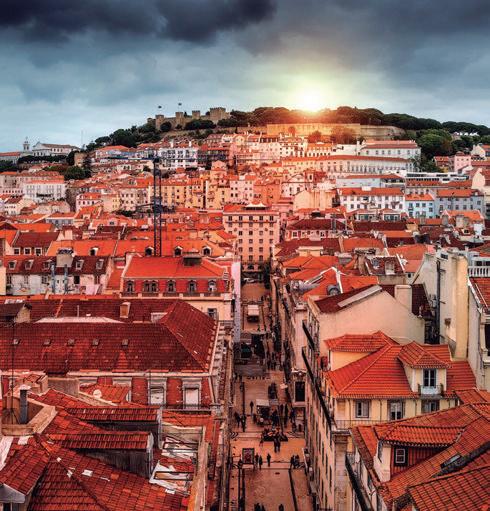
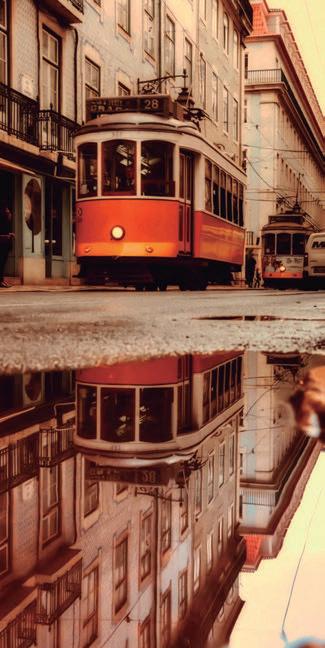

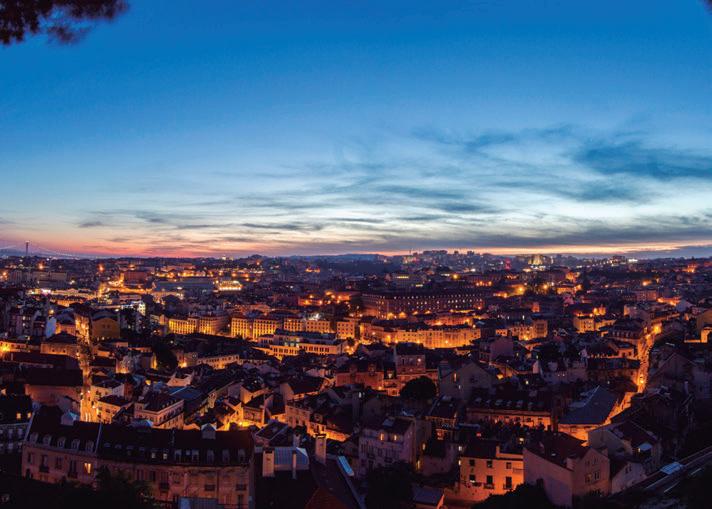
a destruição de Tróia, Ulisses teria visitado uma cidade então conhecida como Ofi úsa, a “Terra das Serpentes”. Era aí que vivia a rainha das serpentes, representando sedução e perigo ao mesmo tempo. Quem ousasse entrar nestas terras, era seduzido e desaparecia para sempre. Quando o viajante chegou, vindo do mar, navegou no rio Tejo e encontrou a rainha de Ofi úsa, que depressa se apaixonou pelo herói grego. A rainha seduziu-o com a proposta da criação da mais bela cidade do Universo à qual seria dada o seu nome: Ulisseia ou Olissipo. Mas, Ulisses não quis fi car e partiu pelo coberto da noite. Homer’s “Odyssey”. It is said that, after the destruction of the city of Troy, Ulysses would have visited a city then known as Ophiussa, the “Land of Serpents”. It was there that the queen of the serpents lived, representing seduction and danger at the same time. Anyone who dared to enter those lands was seduced and vanished forever. When the traveller arrived, coming from the ocean he navigated down the Tagus River and met Queen Ophiussa, who quickly fell in love with the Greek hero. The queen seduced him
INFORMAÇÃO
LISBOA População: 506.654 habitantes* Feriado municipal: 13 de junho, dia de S. António Santo Padroeiro: S. Vicente
PORTO População: 214.936 habitantes* Feriado municipal: 24 de junho, dia de S. João Santa Padroeira: Nossa Senhora de Vandoma *Números Pordata- 2018
P R Ó X I M A P A R A G E MP R Ó X I M A P A R A G E M N E X T S T O P

Quando a rainha descobriu que fora abandonada, serpenteou furiosa pelo rio fazendo tremer a terra. Diz-se que foi assim que nasceram as sete colinas de Lisboa. Existe hoje um painel de azulejos moderno - data de 1996 -, da autoria do artista simbolista português, Lima de Freitas, que evoca esta lenda. Pode ser apreciado no átrio que faz a ligação entre a estação de comboios do Rossio e o metro dos Restauradores. Mas, lendas à parte, a versão mais lógica sustenta que o nome da capital portuguesa tem origem na presença dos fenícios. Povo de marinheiros e comerciantes, oriundos do Mediterrâneo, ao entrarem no Atlântico através do estreito de Gibraltar, subiram para Norte ao longo da costa. Aí, chegaram à foz de um rio onde, após passarem uma zona onde as margens eram mais próximas, encontraram um enorme estuário. É hoje aquilo que se chama de Mar da Palha, o mais largo estuário da Europa, onde se encontra a Ponte Vasco da Gama que, com os seus doze quilómetros, é a mais longa ponte da Europa. Na margem Norte do rio há uma elevada colina, onde se encontra hoje o Castelo de S. Jorge. Do alto da colina oferecia-se uma vista ampla, permitindo garantir a segurança dos primeiros habitantes, que conseguiam antecipar movimentos de inimigos. Na encosta Sul da colina, descendo para o rio, havia água potável. Mais tarde, os mouros chamaram-lhe Alfama, em referência às águas termais. Os fenícios chamaram a este sítio “Alis Ubbo”, que significa “Porto Seguro” ou “Enseada Amena”. É a nossa Lisboa de hoje. Depois dos fenícios, vieram os romanos. E ainda há vestígios dessa época. O visitan-

O nome Portugal tem origem na antiga “Portus Cale” e ainda hoje o Porto é a única cidade no mundo que se chama apenas “Porto”, sem nenhum outro qualificativo. É apenas Porto e ponto final.
The name of Portugal comes from the old “Portus Cale” and is still today the only city in the world that is called only “Porto” (Oporto) without any other qualifier. It is just Porto and that’s it. INFORMATION
LISBON’S POPULATION: 506,654 inhabitants* Municipal holiday: July 13, Saint Anthony’sDay Patron Saint: Saint Vincent
OPORTO’S POPULATION: 214,936 inhabitants* Municipal holiday: July 24, Saint John’s Day Patron Saint: Our Lady of Vendôme
*Figures - Pordata 2018
with the proposal of creating the most beautiful city in the Universe which would have his name: Ulyssippo or Olisipo. But Ulysses didn’t want to stay and left under the cloak of night. When the queen found out that she had been abandoned, she meandered furious through the river making the earth shake. It is said that this was how the seven hills of Lisbon took shape. Presently, there is a modern tiles panel - dated from 1996 - by the symbolist Portuguese artist, Lima de Freitas, evoking that tale. It can be admired at the gallery connecting the Rossio train station to the underground station of Restauradores. But, tales apart, the most logical version supports that the name of the Portuguese capital originates from the Phoenician presence. Being a people of salesmen and merchants coming from the Mediterranean, they entered the Atlantic through the Strait of Gibraltar and went up North along the coast. There, they arrived at a river mouth where, after navigating through a zone where the banks were closer, they found a huge estuary. Today it is known as Straw Sea (“Mar da Palha”), the wider estuary in Europe, featuring Vasco da Gama Bridge which, with its twelve kilometres, is the longest bridge in Europe. On the North bank of the river there is a high hill housing


S. Jorge Castle. From the top of the hill one can contemplate a wide landscape which allowed assuring the safety of the first inhabitants as they could anticipate the movements of the enemies. On the South slope of the hill, down the river, there was potable water. Later, the Moorish called it Alfama based on the thermal waters. The Phoenician called this place “Alis Ubbo”, meaning “Safe Harbour” or “Balmy Cove”. This is our Lisbon today. After the Phoenician came the Romans. And there still are remains of that period. Visitors can see the ruins of the Roman Theatre at Rua da Saudade. The Lisbon Cathedral itself from the 13th century has Roman remains and, in the downtown undergrounds, there are also remains from the Roman period. In Rua Augusta, for example, the Millennium Foundation is open to the public for visits to its foundations featuring more examples of the Roman Empire. The Rossio Square still exhibits an oval shape as it served as a horse race-track. Lisbon was then a thriving city and an important commercial hub supplying the Roman troops between Rome and Great-Britain. It received the name of “Felicitas Julia Olissipus”, the happiness of Julius Caesar. But Portugal still didn’t exist with this name. It was called Lusi-
P R Ó X I M A P A R A G E MP R Ó X I M A P A R A G E M N E X T S T O P
te pode observar as ruínas do Teatro Romano, na Rua da Saudade. A própria Sé Catedral de Lisboa, obra do Séc. XII, tem vestígios romanos e, no subsolo da Baixa, existem vestígios do período romano. Na Rua Augusta, por exemplo, a Fundação Millennium também está aberta ao público para visitas às suas fundações com mais exemplos do tempo do Império Romano. A praça do Rossio ainda hoje exibe uma forma oval já que seria aí que havia um hipódromo para corridas de cavalos. Lisboa era então uma cidade pujante e importante entreposto comercial de abastecimentos das tropas romanas entre Roma e a Grã-Bretanha. Recebeu mesmo o nome de “Felicitas Julia Olissipus”, a felicidade de Júlio Cesar. Mas, Portugal ainda não existia com este nome. Chamava-se Lusitânia e pertencia à Ibéria, abrangendo ainda parte do atual território de Espanha. Os cidadãos eram conhecidos como tania and belonged to Iberia, still encompassing part of the current Spanish territory. The citizens were known as the Lusitanian. After the fall of the Roman Empire, the Iberian Peninsula, between 418 and 711 of our era, was called the Kingdom of the Visigoths. This lasted until the last Visigoth King, Ruderic, was defeated by the Muslim general Tarik, in the Battle of Guadalete, near Cadiz, on July 31 in 711. The Muslim occupation lasted until the 13th Century, when Afonso Henriques entered History ending up to be the first king of Portugal. He was born on July 25, 1109, in the city of Guimarães, located in the North of Portugal. Afonso Henriques was the son of Henry of Burgundy - Count of Portucale - whose name came from “Portus Cale”, today the city of Porto. The father of the one that ended up to be the first king of Portugal, came from

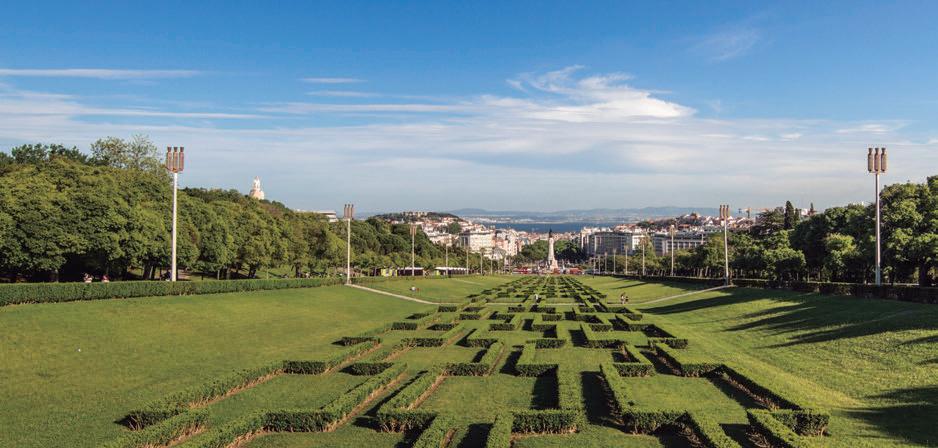
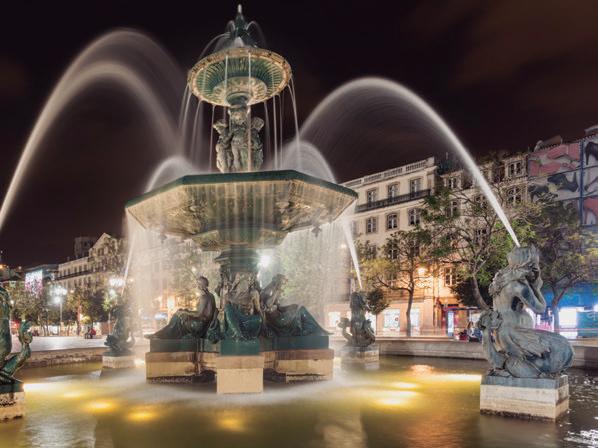
A entrada no Tejo exibe o monumento aos Descobrimentos e ainda a Ponte 25 de Abril, inaugurada a 6 de agosto de 1966 e que teve, então, o nome de Ponte Salazar. Mudou para a atual designação após a revolução que, em 1974, terminou com a ditadura do Estado Novo.
At the entrance of the Tagus estuary there is a monument dedicated to The Discoveries and also the 25 de Abril Bridge, inaugurated on August 6, 1966, then called the Salazar Bridge. Its current name was received after the revolution which, in 1974, ended the “Estado Novo” dictatorship.
os Lusos. Ora, após a queda do Império Romano, houve na Península Ibérica, entre os anos 418 e 711 da nossa era, o chamado Reino Visigótico. Até que o último rei visigodo, Rodrigo, foi derrotado pelo general muçulmano Tarik, na Batalha de Guadalete, nas proximidades de Cádiz, a 31 de julho de 711. A ocupação muçulmana durou até ao Séc. XII, altura em que surge D. Afonso Henriques, aquele que será o primeiro rei de Portugal. Nascido a 25 de julho de 1109, na cidade de Guimarães, no Norte de Portugal, Afonso Henriques era filho de D. Henrique, Conde de Portucale – que tem origem no nome “Portus Cale”, onde está hoje a cidade do Porto. O pai daquele que veio a ser o primeiro rei de Portugal era oriundo de uma linhagem Nobre, pois descendia do rei Roberto II de França que, por sua vez, descendia do Rei dos Francos, Hugo Capeto. A mãe de Afonso Henriques, Teresa de Leão, era filha ilegítima do Rei Afonso VI de Leão e Castela. Situa-se então aqui a origem oficial do nome Portugal, na antiga “Portus Cale” e ainda hoje a única cidade no mundo que se chama apenas “Porto”, sem nenhum outro qualificativo. É apenas Porto e ponto final. Foi noble lineage as he descended from Robert II of France who, in turn, descended from the King of the Francs, Hugh Capet. The mother of Afonso I of Portugal, Theresa, Countess of Portugal, was the illegitimate daughter of King Alfonso VI of León and Castile. The official origin of the name of Portugal lies here, in the old “Portus Cale”, and is still today the only city in the world that is called only Porto without any other qualifier. It is just Porto and that’s it. It was in the year of 1139 that Afonso I of Portugal, after winning the Battle of Ourique, on July 25, day of his anniversary and also Day of Santiago, made himself a knight on his own. Four years later, on October 5, 1143, Afonso I of Portugal signed with his cousin, Afonso VII of León and Castile, the Treaty of Zamora, which established the permanent independence of the new country. And finally, four years later, in October 1147, the King of Portugal arrived at the doors of Lisbon, still occupied by the Moorish. The conquer of Lisbon had the help of the English, Scottish, Flemish, Normans and German crusades, who on their way to Jerusalem had stopped in Porto due to bad weather. As time passed, due to its strategical location right in the middle of Portugal, mastering the Atlantic and benefiting
A PRAÇA DO ROSSIO AINDA HOJE EXIBE UMA FORMA OVAL JÁ QUE SERIA AÍ QUE, NO TEMPO DO IMPÉRIO ROMANO, HAVIA UM HIPÓDROMO PARA CORRIDAS DE CAVALOS.
THE ROSSIO SQUARE STILL EXHIBITS AN OVAL SHAPE AS IT SERVED AS A HORSE RACETRACK BACK AT THE ERA OF THE ROMAN EMPIRE.
P R Ó X I M A P A R A G E MP R Ó X I M A P A R A G E M N E X T S T O P

no ano de 1139 que D. Afonso Henriques, após a vitória na Batalha de Ourique, a 25 de julho, dia do seu aniversário e também dia de Santiago, armou-se a si próprio como o primeiro Rei de Portugal. Quatro anos mais tarde, a 5 de outubro de 1143, Afonso Henriques assinou com o primo, Afonso VII de Leão e Castela, o Tratado de Zamora, que marcou a independência defi nitiva do novo País. E, fi nalmente, quatro anos depois, em outubro de 1147, o rei de Portugal chegou às portas de Lisboa, ainda ocupada pelos mouros. A tomada de Lisboa contou com a ajuda de cruzados ingleses, escoceses, fl amengos, normandos e alemães que, a caminho de Jerusalém, tinham feito escala no Porto devido ao mau tempo. Com o passar do tempo, devido à sua localização estratégica a meio de Portugal, dominando o Atlântico e benefi ciando de condições naturais para o comércio e grandes navios, Lisboa vai-se tornando uma cidade cada vez mais importante, sobretudo quando começa a expansão Marítima portuguesa a partir do Séc. XVI. Com a capital em Lisboa, o Porto fi ca com o título de segunda cidade e capital do Norte. Mas, será ainda no início do Séc. XIX, que o Porto acrescenta o título de cidade “Invicta”, por ter resistido ao cerco montado na sequência da guerra civil de 1832-34. Existe ainda hoje uma assumida rivalidade histórica entre Lisboa e Porto. Como vimos, isso vem de longe. No entanto, ainda bem que assim acontece, pois ambas cidades lutam sempre por agradar ao visitante. Assim, graças à rivalidade, estão sempre a inovar e todo o mundo acaba, deste modo, por benefi ciar de Lisboa e Porto! from natural conditions for trading and receiving big ships, Lisbon becomes an increasingly more important city, mainly with the beginning of the Portuguese maritime expansion in the 16th century. With Lisbon as the capital, Porto is seen as the second city of the country and capital of the North. But it was still in the beginning of the 19th century that Porto received the additional title “Invicta” for having resisted to the siege following the 1832/34 civil war. There is an assumed historical rivalry between Lisbon and Porto. As we have seen, it has long time foundations. However, it has a positive side, as both cities compete to please the visitors. Therefore, thanks to this rivalry, they are always innovating, and the entire world ends up benefi ting and enjoying Lisbon and Porto! SERÁ AINDA NO INÍCIO DO SÉC. XIX, QUE O PORTO ACRESCENTA O TÍTULO DE CIDADE “INVICTA”, POR TER RESISTIDO AO CERCO MONTADO NA SEQUÊNCIA DA GUERRA CIVIL DE 1832-34.













